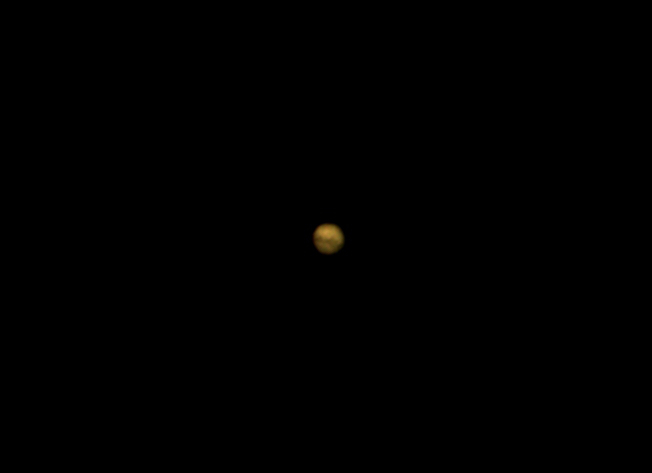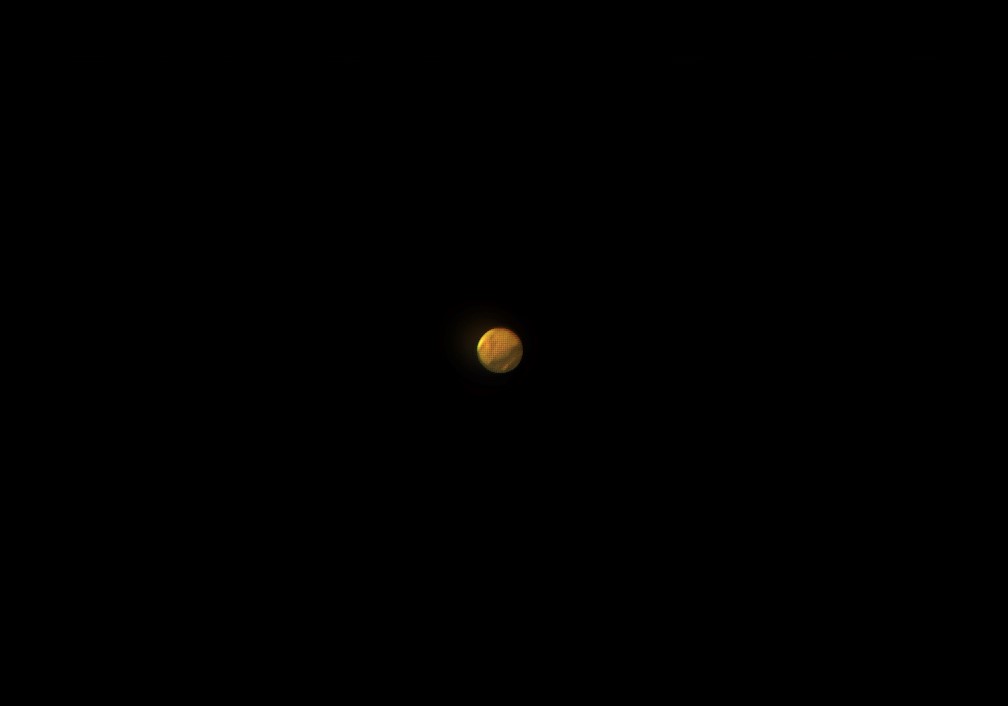Mars

10.1″ f/4.5 (stopped to 3.8″ f/12), Mallincam DS432CTEC with 2.5x barlow
Exposure = 2.696 msec, Gain = 80 of 250
October 18, 2020 04:53 UTC
Mars just past opposition. Major surface features visible are Syrtis Major (dark area to the lower right) and darker southern highlands. Mars south pole is at approximately 2 o’clock slightly inside the limb. Disk size on this date is 22 arcminutes.

10.1″ f/4.5, Mallincam DS432CTEC with 5x barlow and Atmospheric Dispersion Corrector
Exposure = 40 msec, Gain = 3.6 of 250
August 13, 2022 09:02 UTC
Mars is 117 days prior to opposition in the predawn sky in Taurus. Major dark features visible are Syrtis Major on the right side toward the terminator and Sinus Sabaeus running across the disk. On the lower (southern) part of the globe is the bright circular structure Hellas Planitia. The planet is about 70% illuminated and the Martian south pole is at about 5 o’clock on the disk. Mars’ apparent size is just under 9 arcminutes.
Image stacked in Autostakkert using the top 5% of 1009 SER frames, post-processed in Affinity Photo.
North at 11 o’clock, East at 8 o’clock

10.1″ f/4.5, Mallincam DS432CTEC with 5x barlow and ADC
Exposure = 37(?) msec, Gain = 5 of 250
August 28, 2022 06:55 UTC
Two weeks later from previous image. I forgot to record a metadata file for this image so the exposure and gain values are approximate from memory. Goal was to target 2/3 to 3/4 fill on the logarithmic scale of the histogram (a suggestion from Chris Go), which seems to have produced a good brightness/contrast for features; this approach has been working very well on Jupiter and Saturn too.
The dark southern highlands, here Mare Sirenum, are visible on the lower portion of the globe. According to S&T’s Mars Profiler tool, Olympus Mons is very near the central meridian; in this view you can see a very faint blemish just above Mare Sirenum, in the 2 o’clock direction. This would roughly correspond to Olympus Mons since the central meridian would be tilted in that direction due to the south pole tilt towards the Sun (the southern hemisphere is going into Martian summer at this time according to the RASC Observer’s Handbook). A hint of white at the 7 o’clock edge of the planet appears to be a diminished south polar cap. Mars’ apparent size is about 9.5 arcminutes. Seeing conditions on this night were excellent, 5/5.
Image stacked in Autostakkert using the top 10% of 1007 SER frames, post-processed in Affinity Photo and Pixlr.
North at 12 o’clock, East at 9 o’clock

10.1″ f/4.5, Mallincam DS432CTEC with 5x barlow
Exposure = 18 msec, Gain = 7 of 250
November 27, 2022 04:23 UTC
Mars has grown in size since the August 28 imaging, from 9.5 arcseconds to 17 arcseconds over the past 3 months. Unfortunately seeing conditions were quite poor, only 2/5 tonight, however managed to capture some surface details. Did not use the ADC this time since Mars was over 60 degrees above the horizon.
The dark area on the right-side of the image is Syrtus Major, a shield-volcano area whose dark colours come from the basaltic volcanic rock of the region and relative lack of dust. It is also where Perseverance/Ingenuity of the Mars 2020 mission landed.
The dark “belt” across the mid-section consists of Sinus Meridiani & Sinus Sabaeus – Opportunity Rover’s landing location was in Sinus Meridiani. Below the belt to the lower-right is a brighter albedo region known as Hellas Planitia, a large circular impact basin plain. The long thin faintly dark region at the top of the image is Ismenius Lacus; above that, the North Polar Cap which is partially visible during this opposition.
Image stacked in Autostakkert using the top 18% of 1084 SER frames, post-processed in Affinity Photo and Pixlr.
North at 11 o’clock, East at 8 o’clock
Mars at opposition

10.1″ f/4.5, Mallincam DS432CTEC with 5x barlow
Exposure = 10 msec, Gain = 6 of 250
December 9, 2022 01:26 UTC
Seeing is 3 of 5 tonight. Mars is one day past opposition, just over 17 arcseconds across, 82 million kilometers from Earth. The north polar cap is very visible. Just south of the polar cap are dim dark albedo areas in Utopia Planitia and Elysium. Mare Sirenum (right) and Mare Cimmerium (left) span the southern portion of the globe.
Image stacked in Autostakkert using the top 25% of 1280 SER frames, post-processed in Affinity Photo and Pixlr.
North at 11 o’clock, East at 8 o’clock